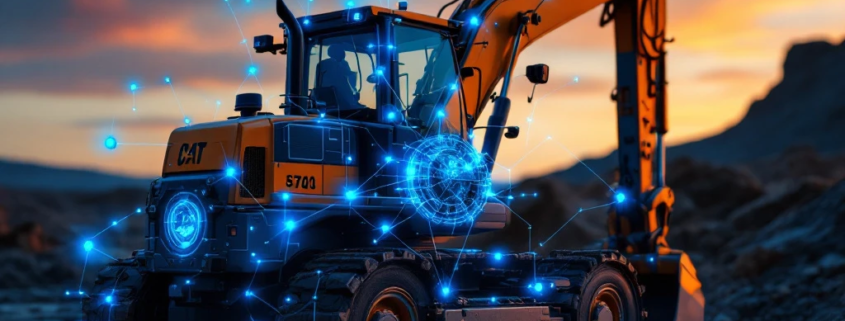How Does IoE Integration Benefit Off-Highway Equipment?
The integration of Internet of Everything (IoE) technology transforms off-highway equipment operations by connecting machines, operators, processes, and data into a cohesive ecosystem. This advanced connectivity enables real-time monitoring, predictive maintenance, resource optimization, and enhanced decision-making capabilities. Construction, agriculture, mining, and forestry industries benefit through decreased downtime, extended equipment lifespan, improved safety, and significant operational cost reductions while maximizing productivity in challenging environments.
Understanding IoE integration in off-highway equipment
The modern industrial landscape is rapidly evolving, with connectivity transforming how machinery operates across sectors. The Internet of Everything represents a powerful framework that extends beyond simple machine-to-machine communications, creating an interconnected ecosystem where heavy equipment becomes part of a larger, intelligent network. For off-highway machinery operating in construction sites, mines, agricultural fields, and forestry operations, this connectivity revolution offers unprecedented opportunities.
IoE integration fundamentally changes equipment functionality by establishing connections between four critical elements: machines, people, processes, and data. By linking these components, off-highway equipment transitions from isolated operational units to intelligent, collaborative systems capable of optimization at multiple levels. This connectivity enables equipment to communicate with operators, other machines, and central management systems, creating a comprehensive operational awareness previously impossible in traditional equipment deployments.
What is the Internet of Everything (IoE) in industrial applications?
In industrial contexts, IoE represents an expansion beyond the more familiar Internet of Things (IoT). While IoT primarily focuses on connecting physical devices to digital networks, IoE encompasses a broader ecosystem that integrates people, processes, data, and things into a cohesive operational framework. For off-highway equipment specifically, this means creating intelligent networks where heavy machinery communicates not just with other machines but with operators, business systems, and analytical platforms.
The distinction between IoT and IoE is particularly significant in industrial applications. IoT might enable basic data collection and remote monitoring, but IoE creates actionable intelligence through comprehensive integration. In heavy machinery operations, this translates to equipment that can not only report status information but actively participate in operational decision-making, maintenance scheduling, and resource allocation—creating a holistic connected ecosystem rather than just networked machines.
For off-highway equipment manufacturers and users, IoE represents a paradigm shift from reactive to proactive operational models, where machinery becomes an active participant in business processes rather than simply an operational tool.
How does IoE technology improve operational efficiency in off-highway equipment?
The implementation of IoE connectivity delivers substantial efficiency gains across multiple operational dimensions for off-highway equipment. Real-time monitoring capabilities provide immediate insights into machine performance, utilization rates, and operational conditions. This visibility allows operators and managers to make informed decisions about equipment deployment and usage patterns, optimizing productivity while reducing unnecessary idle time.
Predictive maintenance represents one of the most valuable efficiency improvements enabled by IoE integration. By continuously analyzing performance data, connected systems can identify potential issues before they cause breakdowns. This shifts maintenance from scheduled intervals to condition-based interventions, dramatically reducing downtime while extending equipment lifespan and operational reliability.
CAN bus technology plays a critical role in enabling these efficiency improvements. By providing standardized communication protocols within equipment systems, CAN bus facilitates the collection and transmission of vital operational data from various components. This technology allows for detailed monitoring of everything from engine performance to hydraulic systems, creating the foundation for advanced analytics and operational insights that drive efficiency improvements.
Fuel optimization and resource allocation also benefit significantly from IoE integration. Connected systems can analyze operational patterns to identify inefficient usage practices, recommend optimal equipment settings for specific tasks, and even coordinate multiple machines working together to maximize productivity while minimizing resource consumption.
What are the key connectivity challenges for off-highway equipment?
Off-highway environments present unique obstacles to effective IoE implementation that differ significantly from controlled industrial settings. Remote locations frequently lack reliable network infrastructure, creating connectivity gaps that can disrupt data transmission and system functionality. Construction sites, mines, and agricultural operations often operate in areas with limited or unstable cellular coverage, requiring specialized connectivity solutions.
Harsh environmental conditions further complicate connectivity implementation. Off-highway equipment operates in extreme temperatures, dusty environments, and high-vibration scenarios that can damage standard communication components. Connectivity systems for these applications require ruggedized design, weather sealing, and vibration resistance to maintain reliable operation under challenging conditions.
Interoperability between different machines and systems presents another significant challenge. Off-highway operations typically involve equipment from multiple manufacturers and of varying ages, creating potential communication barriers. Modern connectivity solutions address this through standardized protocols and gateway devices that can translate between different communication standards, enabling comprehensive fleet integration regardless of equipment diversity.
Security concerns also increase as equipment becomes more connected, requiring robust protection mechanisms to prevent unauthorized access to operational systems and sensitive data while maintaining functionality in low-bandwidth environments.
How can companies successfully implement IoE in their equipment fleet?
Successful IoE implementation begins with a comprehensive assessment of current operations, equipment capabilities, and business objectives. Companies should evaluate their existing machinery to determine connectivity readiness, identify performance bottlenecks, and establish clear goals for implementation, whether focused on maintenance improvement, productivity enhancement, or operational cost reduction.
The planning phase should develop a connectivity architecture that addresses the specific challenges of off-highway environments while supporting business objectives. This includes determining what data needs to be collected, how it will be transmitted in challenging environments, and how it will integrate with existing business systems and processes.
Component selection represents a critical success factor, requiring the identification of appropriate sensors, communication modules, and processing systems that can withstand harsh conditions while providing reliable functionality. System design must consider both on-machine architecture and broader network infrastructure, creating seamless data flow from equipment to decision-makers.
Implementation should follow a phased approach, beginning with pilot deployments that allow for testing and refinement before full-scale rollout. Ongoing management requires clear processes for data handling, system maintenance, and continuous improvement to ensure sustained benefits from IoE integration.
Key takeaways: The future of connected off-highway equipment
The integration of IoE technology into off-highway equipment delivers transformative benefits through enhanced operational visibility, predictive maintenance capabilities, resource optimization, and improved safety. As connectivity technology continues to evolve, these benefits will expand further, creating increasingly intelligent, autonomous, and efficient equipment ecosystems.
Companies seeking competitive advantage in construction, mining, agriculture, and forestry must embrace this connected future, developing implementation strategies that address the unique challenges of their operational environments while leveraging connectivity for performance improvement. TK Engineering’s expertise in CAN bus technology and automation solutions provides a foundation for successful IoE integration, enabling companies to develop robust connectivity architectures tailored to the demanding requirements of off-highway applications.
The most successful implementations will balance technological innovation with practical operational requirements, creating connected equipment fleets that deliver measurable improvements in productivity, cost-efficiency, and sustainability while supporting broader business objectives in increasingly competitive industries.
See how technology powers performance off the beaten path.
Our off-highway case studies reveal how advanced control systems and CAN communication optimize operations in demanding terrain and conditions.



